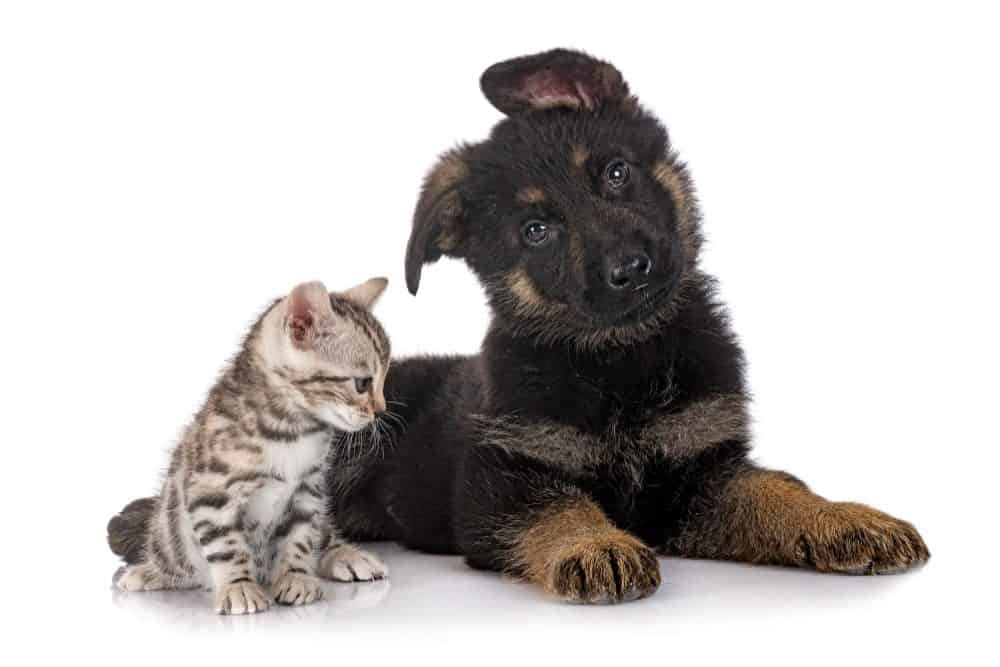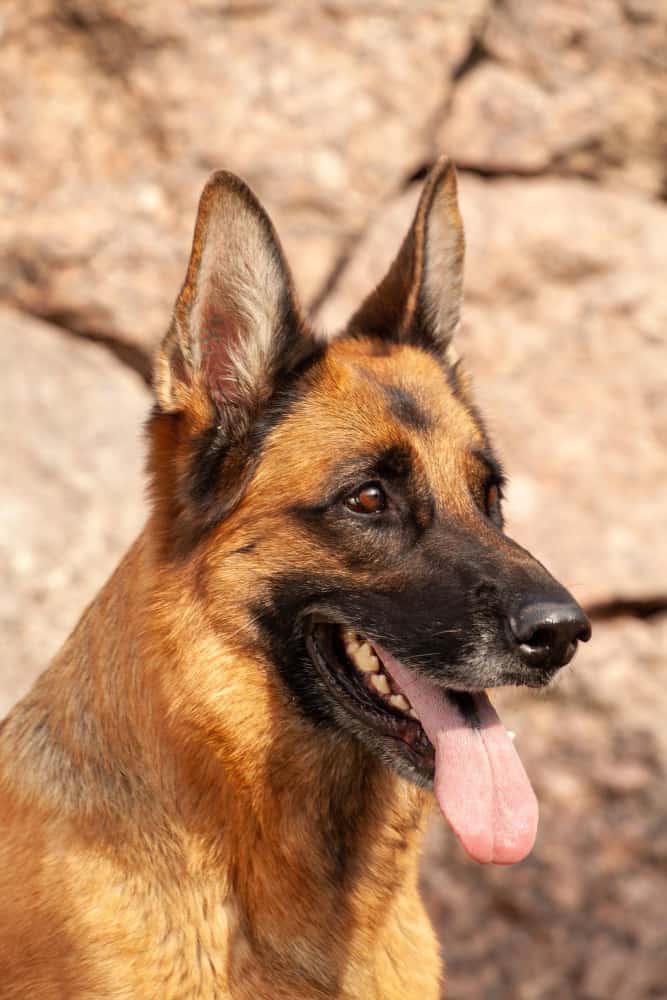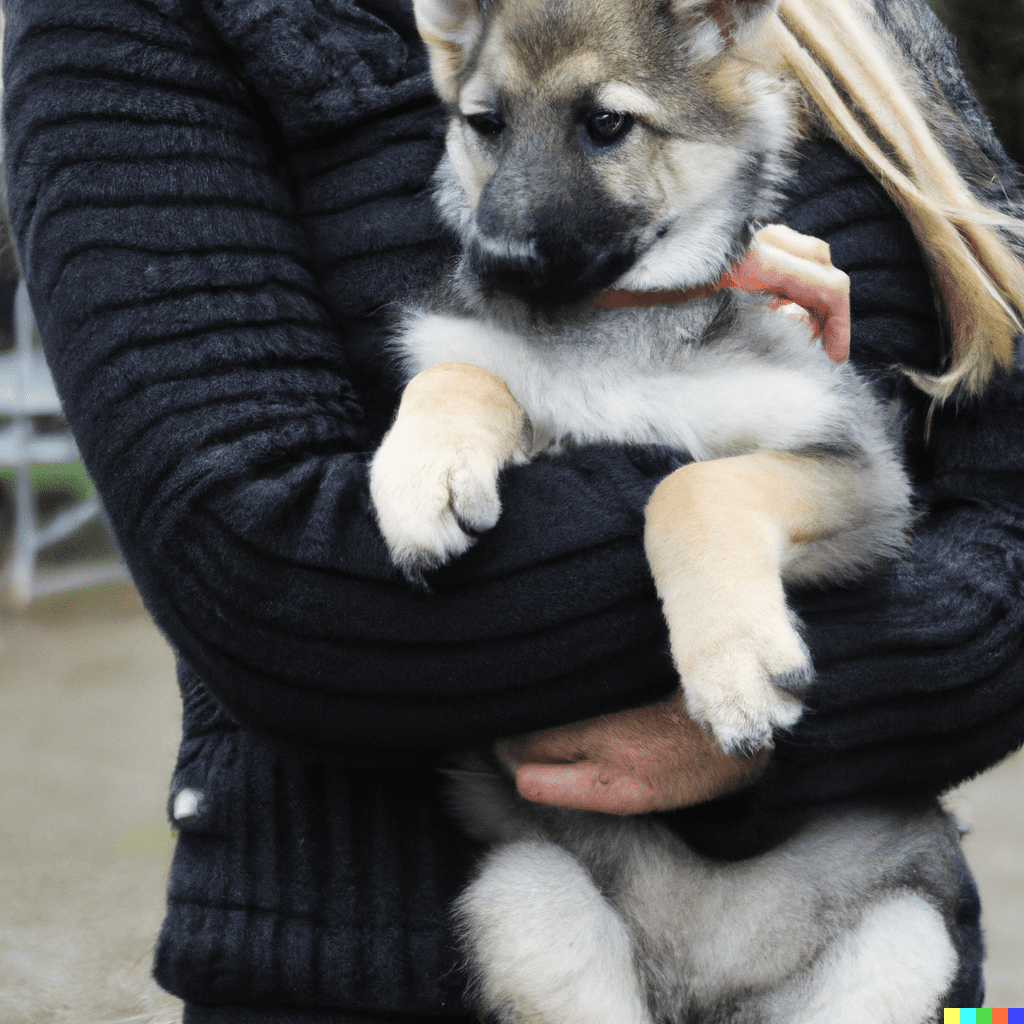Raising a German Shepherd and a cat together needs some amount of know-how, lots of love and patience. This article sets the goal to teach your GSD dog to be gentle around your cat, in some cases, which may not be easy.
Active supervision, creating calm associations, and early socialization/desensitization are some of the most important things when training your German Shepherd to be calm around cats.
German Shepherds are wonderful companions who are highly intelligent, sensitive, and fiercely loyal. When in the right hands, they can be raised into incredible family dogs who can get along with adults, kids, cats, and bunnies alike!
Things to remember when raising a GSD and a cat together
Raising a cat and a dog together will need a ton of micromanagement from the pet parents’ end, especially in the initial stages. Following are a few things to remember before training them to get along with each other:
- Keep their ages in mind. An older animal (beyond 5 years of age) is set in its own way. It’s vital to be patient and understanding of their needs
- Every animal has a different personality. Some are playful, some reserved, some aloof while some are over-friendly. Do not expect an aloof/reserved cat to be super cuddly with a dog
- Set boundaries. Teaching pets to be respectful of boundaries is an amazing way to add some structure in their life.
Can German Shepherds and cats get along?
German Shepherds, although high energy with an innate prey drive, are highly sensitive breeds. Just like most other dogs, German Shepherds need to be socialized young to be calm and accepting of smaller animals like cats.
They are curious beings and like to interact with novel subjects, be it new surfaces, people or animals. When introduced the right way, they have the ability to peacefully co-exist with cats under the same roof.
Watch this heart-melting video of how a GSD and a lovely kitten play together:
A German Shepherd’s natural instinct around smaller animals
German Shepherds were bred to be herding dogs, hence a lot of them still have very strong herding instincts which may naturally surface at the sight of smaller animals.
GSDs also have prominent herding traits like independent thinking and intelligence with a strong prey drive, which may result in them attempting to herd or protect the cat. The more they practice this behavior, the better they get at it.
GSDs are big-time working breeds who were also used as war dogs, watchdogs and guard dogs. Constant human intervention may be required to keep a GSD’s natural instinct in check around cats.
How do I get my dog and cat to like each other?
The most important thing to remember when getting a dog and a cat to like each other is to set your expectations right. If your dog and cat have been living together for a long time and are not really fond of each other, there are very limited things you can do to turn that around. If they aren’t harming each other and are more indifferent rather than friendly, it’s advisable to leave it at that.
If they have been introduced recently or are yet to meet, you can:
- Create positive and calm associations
- Keep interactions low key
- Micromanage
- Avoid overstimulation around each other
How long does it take for a cat to get used to a dog?
Getting a dog and a cat accustomed to each other is dependent on a variety of factors such as
- Age of the animals
- Prior experience with other pets (or with each other)
- The personality of both the animals
- Natural instinct of the dog (chasing, herding, etc.)
- Nature of the play they engage in
- Level of human intervention, etc
There is no definitive answer to this question. It may take a few days, a few weeks, months or in some cases even up to a year for a dog and a cat used to each other’s presence.
How do I know if my dog and cat are playing or fighting?
One of the best ways to figure out if they’re engaging in mutual play is to observe if one of them is pursuing the other. While playing if you see your cat constantly back off and your German Shepherd pursuing them, hold on to just your dog and not your cat. While being held if your cat approaches your dog to play, you may let the play continue. However, if the cat chooses to walk off, stop the play.
The importance of time apart from each other
Animals, especially when they’re young, tend to have a lot of playful energy and almost zero boundaries. This may lead to a lot of boisterous play, especially from your GSD, resulting in hyperactivity, overstimulation, and redirected aggression.
Providing ample time apart from each other will ensure much-needed downtime for both the pets, time to mentally and physically calm down, and will prevent things from going out of control. This will also help maintain calm associations.
Learning to read your pets’ body language around each other
It doesn’t take time for things to escalate, especially when your pets are engaging in rowdy play. Being a responsible pet parent means having a keen eye and a mindful attitude towards your fur babies. It is not rocket science to recognize signs of stress as our pets are constantly communicating with us through body language, whether we know it or not.
Signs that your cat is stressed around your dog
A cat’s threshold is lesser than that of a dog and responds differently compared to its canine counterpart. Following are some common signs of stress in a cat –
- Withdrawing and hiding
- Constantly running away
- Refusal to be in the same room
- Reluctant to play
- Hissing
- Swatting
- Loud, excessive meowing
- Reluctant to eat
- Not approaching anybody and not letting anyone approach
- Attacking and biting
- Screaming
Signs that your German Shepherd is stressed around your cat
Dogs are expressive and have the ability to easily communicate through body language. These are some signs of stress in dogs:
- Slouching
- Ears back
- Whales of eyes exposed
- Constant backing off
- Hiding
- Avoidance
- Growling
- Snapping
- Attacking and biting
- Changes in appetite
- Barking
- Reluctance to interact
8 Tips to train your German Shepherds to be good with cats
1. Start early
Once you welcome home your GSD puppy, introduce them to your cat asap (or vice versa). It’s advisable to do it in a neutral location so that your older pet doesn’t feel threatened.
2. Monitor all interactions closely
It’s vital to monitor all interactions closely to avoid escalations and discomfort between your pets. Intervene when necessary and allow only healthy, playful behavior.
3. Keep your dog engaged in calming activities around the cat
Dogs are creatures of discipline and they learn best through repetitive associations. Engage your dog in productive games and structured activities around your cat in order to channel their chasing, herding and/or protective instincts.
Games and activities that will help keep your dog calm
- Interactive feeding through Kongs and toys
- Edible, long-lasting chews like bully sticks
- Sniffing games
- Hide and seek
- DIY agility
- Puzzle game
- Trick training
4. If you have a hyper pup, have them on a leash around your cat
Hyper and playful pups have boundless energies and often have zero self-control over it. Having them on a leash will help you better contain their energy and proactively teach them desirable behaviors around your cat while continuously reinforcing them.
5. Don’t let them “figure it out” all the time
If your pets keep getting into a fight repeatedly in your presence, they will soon lose confidence in you as a leader. Intervene when you see the slightest sign of stress or discomfort in either one of your pets and teach them the right way to go about it.
6. Give both your pets a safe place to go when they are overwhelmed
Animals generally opt for the Flight option before fighting when they are in a conflict. Make flight options easily accessible by giving both your pets a safe haven to call their own.
7. Avoid chasing games if one of them doesn’t enjoy it
German Shepherds enjoy a good chase. However, it may or may not end well all the time. If even one of your pets is uncomfortable with the game, put an end to it.
8. Master Basic obedience with your German Shepherd
GSDs were bred to be working dogs and are usually very responsive to humans. Mastering obedience with your GSD will enable flawless communication with your pup in any given situation.
Some cues that will help you keep your GSD under control around your cat
What’s the point of teaching a dog anything if we cannot use it in real-life scenarios? Following are some cues you can use to teach your pup to be calm around your kitty –
- Redirection cues like “look” and “touch”
- Stay
- Leave it
- Settle down
- Come
How to train a German Shepherd not to go after my cats?
Proactive intervention and controlling and managing the situation are 2 ways to ensure your GSD is not going after your cats. Proactive intervention can be done in the following ways:
- Having a leash ready
- Actively redirecting the dog
- Engaging the pup in structured games
- Breaking up an interaction before it goes out of control
Control and management of the environment can be ensured through the following ways:
- Baby gates to separate them
- Keeping them in separate rooms
- Tire out for the dog to ensure containment
- Crate training
What should I do if my German Shepherd attacks my cat?
Attacking may be a result of several possible factors like low tolerance to certain behaviors due to social maturity, resource guarding, food aggression, high prey drive, etc. After getting to the root cause of the behavior and identifying the level of aggression, here are some tips you could follow:
- Prevent your animals from being in the same situation again
- Your cat’s safety should be your no 1 priority
- Behavior modification programs
- Desensitize your animals towards each other
- Always have a barrier between them or your dog on a leash
- Potential health issue
- Consult a professional
- Consider rehoming one of your pets for a better life prospect for both of them
Conclusion
Getting your German Shepherd to be a little nicer to your cat takes time and patience. And hopefully, we have given you a fair amount of tips to train your German Shepherds to be good with your cats. Good luck!
Further questions
Can German Shepherds be around cats?
For a German Shepherd and cats to live together, you will need your dog to be calm and super responsive to your verbal and visual cues, so much so that they can reliably disengage even from a highly stimulating play with the cat.
What to do if my cat attacks my dog?
A cat typically ends up attacking a dog when they’re threatened by its presence in any way. In order to avoid it, provide your cat with ample isolated space to call their own, reinforce calm behavior and prevent triggering scenarios from repeating themselves.
When to seek professional help before things go out of hand
Professional help must not be considered as a last resort. Rather, you must take professional help when you see even the tiniest hint of conflict between your pets. Trainers and behaviorists are not magicians who will magically train your pets to love each other. They will help you understand your pets better, guide you on fulfilling their needs and train you to communicate with them effectively.
Eric is a dog lover and a blogger. He loves spending time with dogs more than with humans. You will find him training himself for the next marathon when he is not writing. And he loves Thai food~




